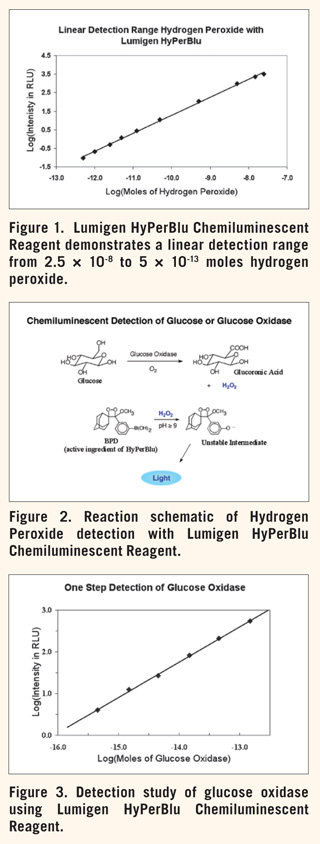Lumigen HyPerBlu provides sensitive chemiluminescent detection of hydrogen peroxide
互联网
Abstract
Lumigen HyPerBlu reagent is a one solution chemical substrate based on dioxetane chemiluminescent technology. With HyPerBlu reagent, a direct reaction with hydrogen peroxide produces an intense sustained luminescent signal making it an excellent choice for examination of oxidase activity. The signal intensity is sufficient for measurement on PMT based plate reading luminometers or CCD imaging systems. HyPerBlu technology detection is suitable for automation and miniaturization to 384-well or 1536-well format. HyPerBlu reagent’s wide tolerance for common assay additives (e.g., DMSO), lack of intermediaries, chemical specificity, one-component structure, and excellent stability lead to assay simplicity and excellent robustness.

Materials
- PMT luminometer (Labsystems)
- 384-well white microtiter plates (Generic)
- Urea peroxide standard
- Oxidase enzyme
- Lumigen HyPerBlu Chemiluminescent Reagent
Protocols
- Prepare well with oxidase and analog as appropriate for chosen study.
- Add 5 µL standard or sample to each well.
- Incubate per oxidase characteristics.
- Add 5 µL Lumigen HyPerBlu Chemiluminescent Reagent.
- Incubate 20�30 min at room temperature.
- Detect with 1-s integration per well for PMT luminometer systems, or 5 s per plate for CCD imaging systems.
Data Analysis
Lower detection limits (LDL) and dynamic range for Lumigen HyPerBlu was determined by preparing a dilution series of urea peroxide standards. The signal obtained was plotted against the standard concentrations tested in the assay. The LDL was determined by using the background mean + 3 × sd.
Glucose Oxidase Test Assay
Glucose was oxidized with glucose oxidase in aqueous solution and the peroxide generated was assayed with Lumigen HyPerBlu (Figure 2). Solutions containing 1.5 × 10-13 to 4.5 × 10-16 moles of glucose oxidase were analyzed in triplicate, in a one-step format. Wells were incubated at 25ºC with a solution of 0.1 M glucose. Chemiluminescence intensity was measured at 22 min.
The glucose oxidase assay shows a linear response over the tested range (Figure 3). This same method could be used in a study of enzymatic response to various conditions or in a detection test for glucose itself.
Results and discussion
As shown in Figure 1, an LDL of 5 × 10-13 moles of Hydrogen Peroxide was achieved. The wide linear dynamic range of 5 logs gives this assay great flexibility to measure a variety of processes with minimal process scaling.
Stability of performance of Lumigen HyPerBlu when stored at 2�8ºC was shown to have a variation of <5% in one year. When Lumigen HyPerBlu is kept at 23ºC, the product stability shows a variation of <3% in 31 days. This ease of use can be compared favorably with traditional peroxide detection technologies that require biological detection components.










